It’s no secret: homesteading life and projects cost money.
There’s the materials, the tools, time and all the little parts and pieces for this ONE THING you can’t do without to complete the project. Even a small project can easily go over budget.
It’s frustrating, because you’re trying to live a more “simple” life, yet it can still cost $$$.
Here’s where you got to get scrappy. Creative. Think outside the box (stores) and find alternative ways to get it all done.
That’s where I come in – Beth here, the other half of High Sierra Permaculture. I’m the resident thrift finder. Somehow I have a superpower-like beacon toward free piles, deals and discounts wherever I go. So I want to share some thrifty ways we’ve been able to afford our homestead, while still making it look awesome and have the things we need.
Ecological Building
The creation of new products uses a tremendous amount of energy and this contributes to the pollution of our soil, water and air.
In addition, production of new products tends to denude landscapes, often in poor counties, by deforestation, mining and more. To add insult to injury many of these products produce toxic chemicals in the creation process and are also toxic themselves.
Pretty nasty right?
Modern American culture is a throwaway society. If something is used, dirty or kinda broken it goes to the dump. Most have lost the skills of generations (and centuries) before us that lived from the saying “Fix it up, wear it out, make it do, or do without.”

Enter permaculture.
Permaculture is all about re-using and repurposing. When we re-purpose and re-use we are reducing the need for companies to destroy landscapes for resources, and reducing the need for chemical production.
So whether your needing tools or materials, there are some go-to places we always check before heading to the stores.
Gettin’ Eco-Thrifty
Whether your needing tools or materials, there are some go-to places we always check before heading to the stores.
1) Craigslist
Why, of course. But there’s more to it than just perusing the FREE section or searching for that specific thing you need.
Where we’ve found really awesome scores are the deals in-between the lines.
Items that need a little love
If you’re handy, you can often snag a great deal from someone who can’t or doesn’t want to fix their item before selling. If you’re up for the challenge, look for things that may need some extra attention (but are not beyond repair). Often these can be free or highly negotiable, so your risk can be minimal.
For example a high-end dishwasher that needs a new motor. I’ve seen these for free, folks just want them gone – but for often less than $100 you can fix it up in just a few hours.
We also saved thousands on a generator this way. The person selling didn’t want to futz with it and gave it to us for a few hundred dollars. Bret’s amazing skills with motors had that puppy purring in no time.
 Huge Lots
Huge Lots
When I first began my collection of woodworking tools, I was searching for individual items. However, I came across an older gentleman who was retiring and selling all his tools.
I was able to snag a bunch of tools and got a crazy discount because I was taking so much off his hands.
Again, it’s those little things that can add up, so if someone is selling a box of miscellaneous items, often what you pay for the whole box can pay for itself in just one tool. Pass along or get rid of the ones you don’t need.
Same goes for someone who is done with a construction project and has leftover supplies. The items may be random and you might get more than you need – but the overall cost can be far less than purchasing new.
Less-than enticing posts
This one can be really hit or miss, but if I feel I’ve exhausted my search on CL for the items that stand out to me – I start emailing about the ones that perhaps don’t have a photo or much for a description.
It’s a shot in the dark, but I email the seller asking for a photo and more details.
Sometimes they come through with more info. This worked well when I was looking for a specific type of refrigerator where the nice ones went fast and there wasn’t much to choose from.
In this case, I was able to finally score the item because they didn’t have others who were interested (likely given to their unappealing listing).
Proper advertising works well, but also the opposite can work to your advantage.
2. Re-Store
If you’re not familiar, Habitat for Humanity has stores all over the country that sell building materials, kitchen appliances or furniture.
In my experience at the Re-Store, it may take a creative eye to see how you can use the materials, however.
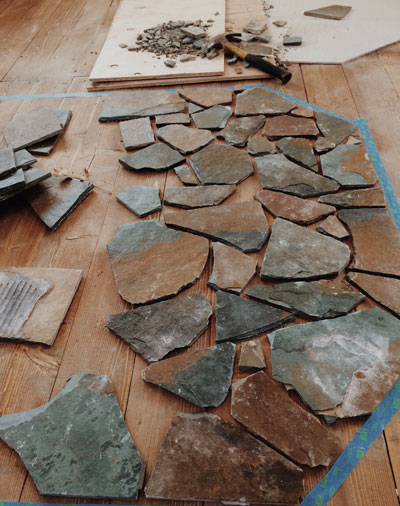
Often they are remnants of larger projects, so the amount of one particular item may not be enough for your needs.
I actually love this though – making an art piece out of the random boxes of tile, instead of a cookie-cutter look. Like this broken slate we used for fireplace hearth.
Or perhaps your project is on the smaller side, you actually might have enough to finish.
It’s also a great place to get materials for projects that don’t have to look amazing.
Our chicken coop has a smattering of hinges and handles found there – it’s funky, but it’s functional!
You can also find things like huge coffee tins of screws and nails or half-used gallons of paint that cost next to nothing.
Advice for this store is: go often and don’t get discouraged if you haven’t found what you’re looking for. It might pop up next time, or if you see something you just know you’ll use and love for a future project, snatch it up. At worst if you don’t end up using it, you can sell it.
Many of the similar concepts from Craigslist apply here too. Look for large lots, broken items and ask for discounts.
3. Use What Your Land Provides
Depending on the size of your land, there might be hidden resources in your backyard.
 Using trees in various forms is likely the most abundant resource you may have.
Using trees in various forms is likely the most abundant resource you may have.
From our land, we’ve used tall thin pine trees in similar places where you would use 2x4s (though I recommend not doing this for anything that is load bearing) for farm built projects around the gardens.
Instead of buying wood for fence posts you can use tall and straight trees as well.
Need a garden trellis? Look around your land for branches and small saplings that can be used.
Tree stumps can be used for anything from benches, seats, garden edges and more.
If you really have a lot of wood on your property, it might be worth looking into a portable Alaskan mill.
With this tool, you can mill up lumber for siding, shelves or even dimensional lumber.
Rocks are also a free resource that might be just under your feet.
These stones can be used these stones for backfill, keeping soil from eroding, for creating roads through wet areas and for building small retaining walls.
Our land is blessed to have plenty of both cobblestones and small granite boulders.
Natural Building
While this article is not about Natural building, I do want to mention that you can build using earthen materials, even entire homes!
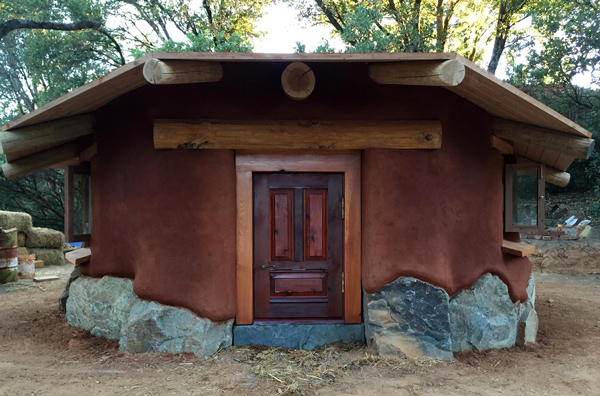 If you have clay soil, for example, you can use this as a part of the mixture to build structures, benches and more with cob. Large boulders can be used for the foundation of small cob outbuildings, like a sauna we helped our friends build
If you have clay soil, for example, you can use this as a part of the mixture to build structures, benches and more with cob. Large boulders can be used for the foundation of small cob outbuildings, like a sauna we helped our friends build
Straw bale homes can be made from local straw and on-site clay. There are lots of possibilities, and of course, there are tons of resources online for natural building.
4. Facebook Yard Sale Groups
I love local community yard sale Facebook groups for a few reasons. Unlike Craigslist, you can see if anyone is already interested in the time and be ready “next in line” (NIL) if it falls through.
But what I like even better is the responses I often get to my random “in search of” (ISO) posts.
Maybe someone hasn’t gotten around to actually listing that old faucet or piles of wood – but they are happy to chime in with what they have to sell.
Often it’s usually for less $ than someone actively selling it because they’d love to see it go to a new home.
Fair warning though, these groups can be addictive – with new items popping up all day.
If you aren’t in any yard sale groups, the best way to find them is to use the search bar at the top and type in your city/town plus “yard sale” and or “sale groups” or “buy sell trade.” You can also check out the Marketplace in the left-hand column. This has similar search features like Craigslist.
5. Unexpected Places
Free Piles
I don’t know about where you live, but in our town especially in the spring and summer months, there are always piles of FREE stuff at the end of the driveway.
Sometimes it’s just pure junk, but we’ve scored anything from ladders, slate flagstones, solar dehydrator, a kids sandbox, shelving, a beautiful rocking chair, miscellaneous fencing, funky old wood and piles of who knows what else.
It’s become a fun little game, to pull over at check out what might be a great score. And, before taking your unwanted items to the dump – pay it forward and give this a try!
Demolitions
Sometimes listed on Craigslist, are folks looking to get rid of materials from a demolition.
It’s a win-win for both of you – they don’t have to take it to the dump, and you can rummage to find building materials.
A few times, I’ve even stopped at an active demo and asked if I can have some of the tear-down.
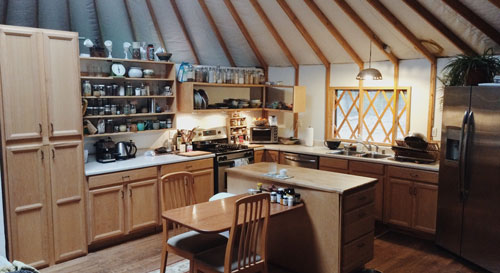 Depending on the situation, you may be asked to assist because keeping materials in good condition can take more time, rather than just tearing out, but you could walk away with windows, flooring or useable lumber (just watch out for nails!).
Depending on the situation, you may be asked to assist because keeping materials in good condition can take more time, rather than just tearing out, but you could walk away with windows, flooring or useable lumber (just watch out for nails!).
For example, all our kitchen cabinets, countertops and shelves came from a tear down. The appliances came from someone on Craigslist upgrading their kitchen. All together, this whole kitchen cost less than $2k!
Windows
Speaking of windows, if you’re on the look out for some windows that don’t need to be high quality or energy efficient (say for applications like a small outbuilding, shed or greenhouses), ask around at stores that sell/install windows what they do with the old ones.
The glass company in our town has piles of old windows they have removed from client’s homes, likely replacing them with energy efficient upgrades. It was here we got piles of windows that are resting in our “boneyard” waiting to be built into a greenhouse.
Rural Yard and Estate Sales
Folks with more space tend to collect more things it seems, making rural yard and estate sales great places to take home piles of tools, wood and other outdoor miscellaneous homesteading items.
Going on the last day and making an offer on a large lot is another easy way to walk home with a lot of goodies, because the sellers are happy just to have it gone.
The Dump
Or also called the transfer station in these rural parts. Now, this may not exactly be within the rules, but as folks are unloading trucks and trailers of items to go to the landfill, you might just see something you could use – and save from becoming waste!
Really, it’s quite heartbreaking to see all the still-useable things that people just throw away.
There has been more than one occasion where I was loading other peoples “junk” from their truck into mine and leaving the dump with great usable stuff.
The Devil’s Advocate
It is interesting to see the responses we’ve gotten when posting pictures of building without traditional materials.
For example, once Bret built a series of stairs out of pine tree logs he halved with the chainsaw.
 It took less than an hour and cost nothing to do. Yet some of the comments on this photo were focused on “that isn’t going to last“ or saying we’d be better off building it out of produced cement bricks etc…
It took less than an hour and cost nothing to do. Yet some of the comments on this photo were focused on “that isn’t going to last“ or saying we’d be better off building it out of produced cement bricks etc…
And while this is true, perhaps it would last longer – but what is the trade-off? That is the ultimate question.
Any long-lasting purchased material would have a negative ecological effect on the world, likely to be paid for by someone in a future generation.
Life is always a balance and we aren’t always able to make 100% eco-friendly choices, but in cases like the stairs, I’m happy to rebuild every 5-10 years if needed. For free.
From One Eco-Thrifter to Another
I’d love to hear YOUR favorite ways to find used and cheap materials.
Leave them in the comments below!



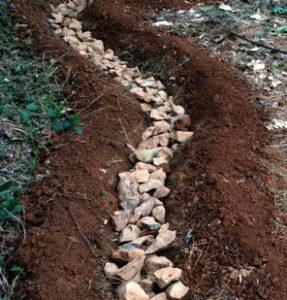


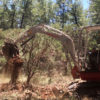



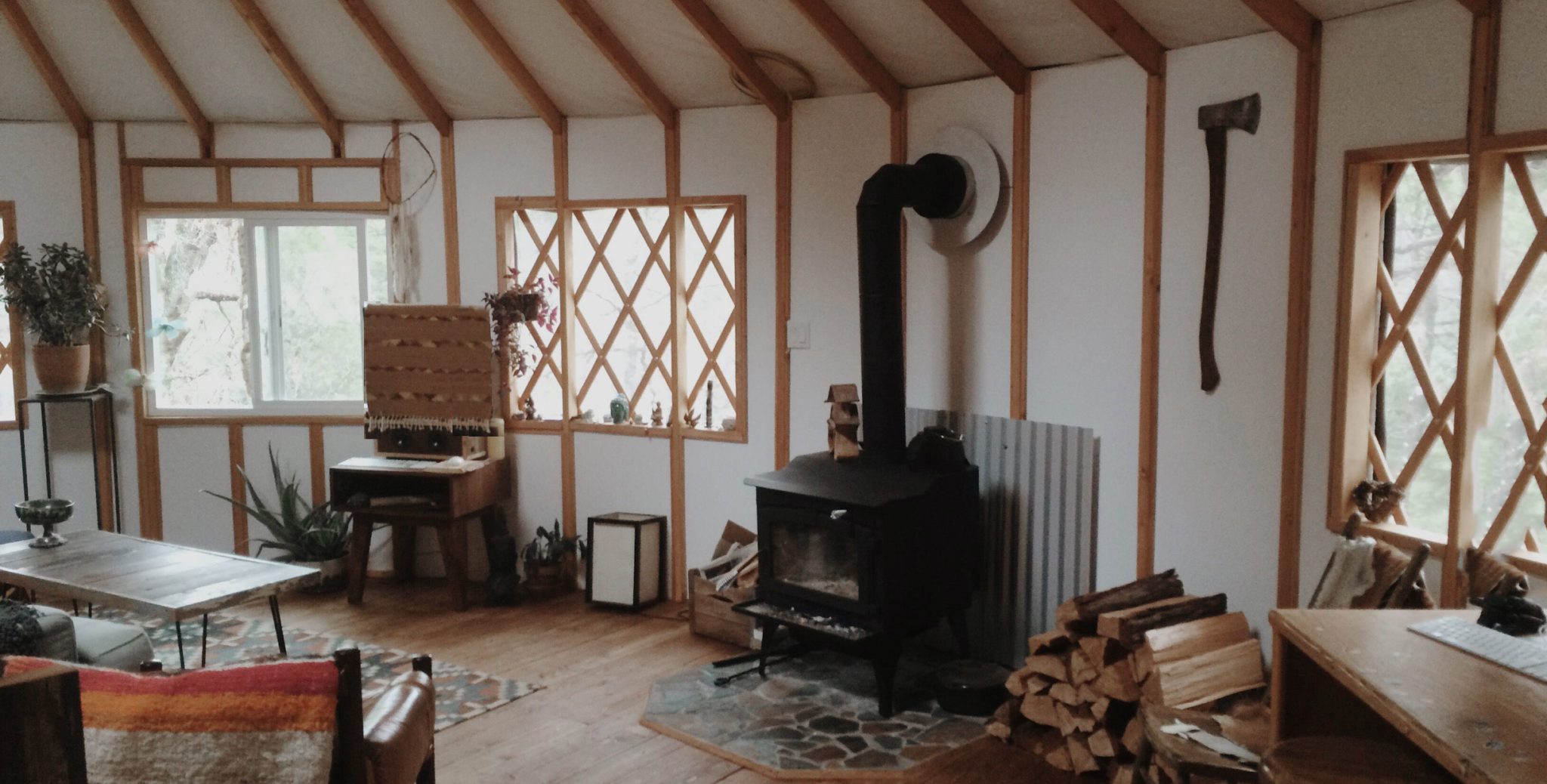
I have a steep hillside out my back door patio area. I built a rectangular frame out of pieces of wood around the 10 acres we purchased and found some halved paving bricks that I placed beside it as stairs. I then started collecting medium-sized rocks around the property and placed those on either side of the stairs. It looks lovely, works to help hold the hillside up when it rains, and I now have a great herb garden out my backdoor patio area. Everyone comments on it when they visit, and it’s always a work in progress. As I find more rocks, I incorporate them into the hillside to help as a retaining wall, and it is making a lovely rock garden where I have placed some hens and chicks to help fill it in. 🙂
My thrifty project this year was using perforated tile on top of a Stony area, standing on end as a tomato extender. I anchored it with rebar so it wouldn’t fall over in the strong winds of NW Ohio storms. TaDa. My extra tomato seedlings are growing tall and when I water, the extra water comes out the perforations and into the ground below but not the soil. As a bonus , because the tile filled with dirt stands taller, I do less bending with these tomatoes.
Hi guys, love your effort – nice postings, we live in Homer Alaska, and yes we do know Atz. So my questions are diverse so i’m going to start with an important one: what about fire preparedness ? I’m sure you’ve been following the Paradise fire…. thanks Chas
Hey Chas, for sure fire preparedness is critical, likely even where you are. Our land is about an hour and half from where the paradise fire happened. Its a big topic, any questions in specific? I can start by saying it is all about understanding the fire regime in your region and being able to evaluate the landscape to determine its health. These are the two biggest clues to being able to know what to do to mitigate and prepare.
Hi Bret, i’ve had some experience in dealing with fire,in the late 70’s we lived on a commune in the Santa Cruz mountains and helped fight and successfully contain and extinguish a 2 acre woodland fire there – we were very lucky there as there was no wind that day and it began to rain that night, years later my rental house burned down (due to a poorly installed stove pipe which came loose in a 5.5 quake overnight while i was sleeping – learned the lesson of not trusting other people’s work on that one – i was injured and loss 90% of personal property), a year later some communal property i was involved in was located in the middle of the 54,000 acre Grass Valley fire (i fought in that one for 3 days and we saved 13 structures – learned many lessons there especially about how Cal Fire prioritizes – that fire started from a homeless guy burning the toilet paper in his poop pit about 5 miles from us ). Then most recently my girlfriend’s 90 yr old father has been dealing with the Paradise fire (he lives there – he survived as did his house – even tho he evacuated by noon the first day he had an excellent 100 ft 360 degree fire break and was located in what turned out to be a strategic location for the wind/fuel dynamics of his scene – so that was maybe 80% preparedness 20% luck as 3 out of 5 of his cul-de-sac neighbors burned – the other house that survived in that cul-de-sac was because his neighbor the owner of that property had backup gen power, a well, hoses and a filled large water storage tank and he stayed and fought it – even then a shed burned on that guys property.
Some of what I’ve learned is Do Not Rely on government fire or emergency response (they are hopelessly under equipped, under manned and bureaucratically hamstrung while even tho at the same time the rank and file are epicly brave, hard working and selfless, they just are no match for massive fire scenarios or even individual structure fires in even semi remote areas as the response time is just too long in most cases).
Rely more on preparedness – like fire breaks, understanding how fire is likely to behave in situ (i.e. in the forest fires i’ve fought in 99% of the structure fires that began were from dry grass/weeds/leaves debris that was up against the building or dead leaf debris in the rain gutters igniting from air borne embers).
So preventative-ly speaking strict adherence to building fire codes (even to the point of well over code) and then personal fire response readiness in terms of plan(s) (both evac and fight/fire plans) and equipment (besides on site elevated large capacity water storage my personal favorites are having on hand Nomex gear, a reliable chainsaw, the 4 gallon backpack sprayers with Easy access side pump handle, a 4 wheeler setup with a 30 – 40 gallon Portable Water Transport Tank with both mechanical and electric pump capability and a small trailer setup with at least 100 gallon capacity, a gas powered trash pump and fill hose for filling from ponds and streams)
Plus i can’t say enough about metal roofs, Roxul insulation, extra sheetrock thickness and in terms of wood stoves secure stovepipe fastening along with stovepipe caps utilizing two stainless steel mesh layers with outer wall of mesh being 3/16″ openings. and last but not least “if in doubt get out”
If you have anything to add i’m all ears. plus i hope that didn’t come off as a lecture. When i began reading your blogs i recognized a kindred spirit a younger tho more advanced version of me (i wish i’d had your awareness when i was your age – what you had to say about about how to determine and sustain one’s self via right livelihood particularly resonated and shows a thorough comprehension of an extremely important tho often overlooked spiritual principle – well done).
I’m 65 now and felt compelled to put out this fire info on a savvy back 2 lander site. Probably because of the intensity of what we’ve been experiencing familiarly via the Paradise fire.
Hey Chas,
All great input here – thank you!!
I think the thing to add is the URGENCY in which we need to be taking action – both in direct response to the immediate fire threats and the longer term problem of a warming climate that is increasing the scope and scale of these fires.
There are tons of small thing that can be done but coming together as communities and taking responsibility for our own land is paramount. We need to used mechanized means to get our forest under control (the underbrush) and then allow animal grazing and controlled (cool downhill style) burns going forward.
If we can keep the fire out of the canopy the fires are way more controllable and less devastating.
Also, moving towards earthen style buildings which are pretty much fire-resistant.
I think we humans are in a huge learning curve with living in the human-wildland interface and we need to learn our lessons quickly.
Portable alaskan sawmill link leads to a picture of some intertwined twigs.
Thanks for the heads up – link is corrected.